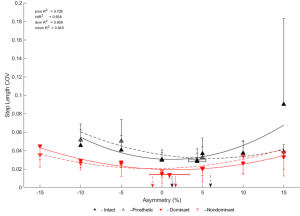Coordination and Stability with Walking
Coordination and Stability with Walking
Project Leads: Ashley Arensdorf , Tori Urban
*Unpublished data: Step length coefficient of variation (COV) for people with and without amputation that walked with varying levels of (a)symmetry; publication in process
People with structural (e.g., amputation) and neurological (e.g., stroke) conditions walk with asymmetric patterns that may be optimal over symmetric walking, even though interventions commonly focus on restoring symmetry. Symmetric gait has been a focus of rehabilitation because asymmetric gait has been correlated with issues such as falls and osteoarthritis. It is unclear how people who walk asymmetrically coordinate movements and how preferred movements are affected by coordination and stability. The purpose of our coordination and stability studies are to understand how people with and without injury coordinate (a)symmetric walking mechanics. We have people walk with preferred patterns and then provide real time feedback about gait mechanics to encourage non-preferred patterns, which are symmetric for people with amputation and asymmetric for able-bodied individuals. The long-term goal is to understand the role of coordination and stability with preferred patterns so we can improve rehabilitation and device design.
If you are interested in participating in the study:
Presented Work
- Urban & Arensdorf 2022 APTA CSM Stance Phase Symmetry and Metabolic Cost of Locomotion in People with Unilateral Transtibial Amputation
- Abstract
- Andrejchak & Urban 2021 NCPTA Coordination Variability in People With and Without Unilateral Transtibial Amputation
- poster
- Wedge & Emmerik 2021 APTA CSM Stance Phase Symmetry and Gait Stability in People with Unilateral Transtibial Amputation
- Abstract
- Wedge & Andrejchak 2021 ASB Coordination Variability In People With And Without Unilateral Transtibial Amputation
- Abstract
- Wedge & Andrejchak 2021 ECU CAHS Research Day Coordination Variability in People with and without Unilateral Transtibial Amputation
- Abstract
- Poster
